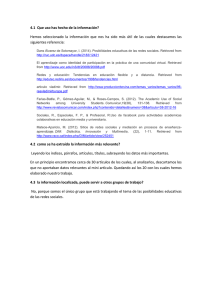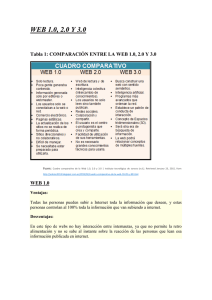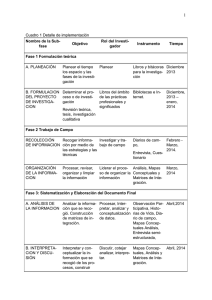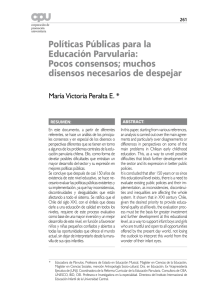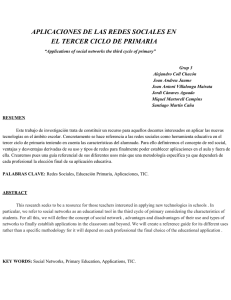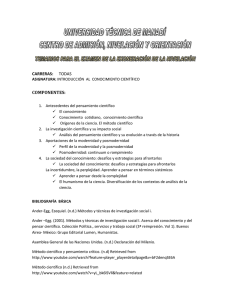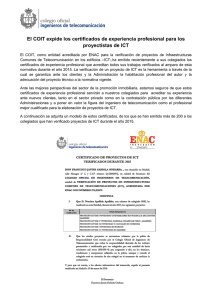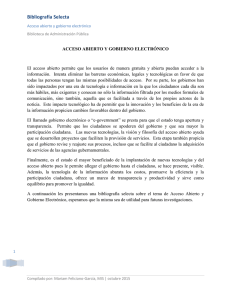ical resources, or have the possibility of updating and improving the
Anuncio
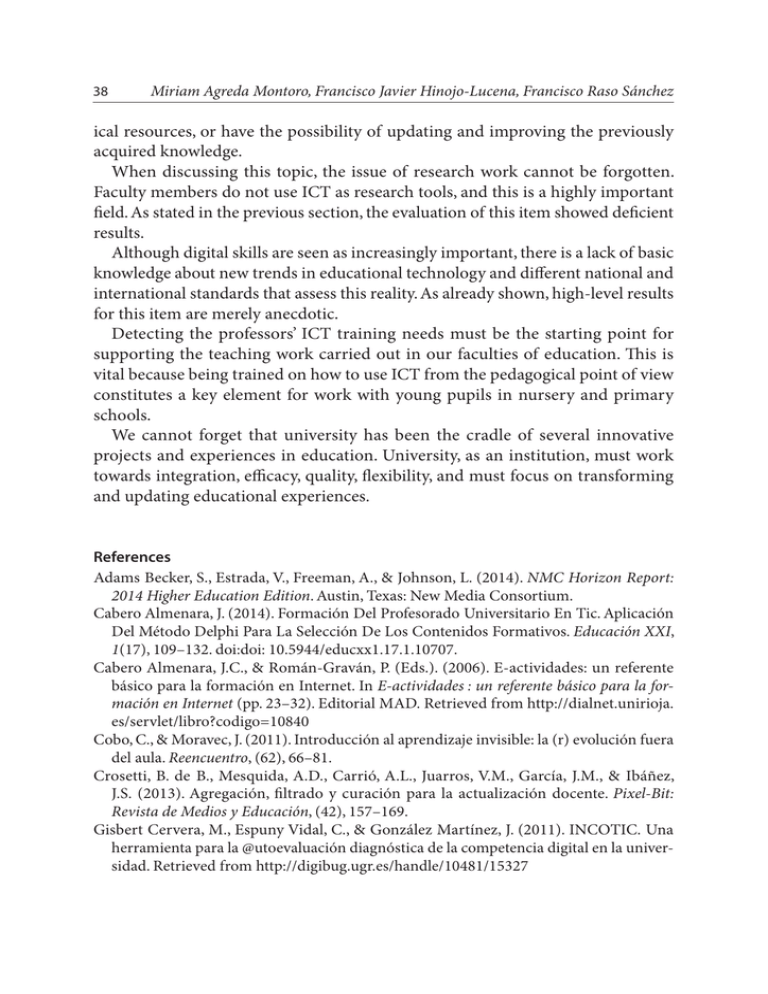
38 Miriam Agreda Montoro, Francisco Javier Hinojo-Lucena, Francisco Raso Sánchez ical resources, or have the possibility of updating and improving the previously acquired knowledge. When discussing this topic, the issue of research work cannot be forgotten. Faculty members do not use ICT as research tools, and this is a highly important field. As stated in the previous section, the evaluation of this item showed deficient results. Although digital skills are seen as increasingly important, there is a lack of basic knowledge about new trends in educational technology and different national and international standards that assess this reality. As already shown, high-level results for this item are merely anecdotic. Detecting the professors’ ICT training needs must be the starting point for supporting the teaching work carried out in our faculties of education. This is vital because being trained on how to use ICT from the pedagogical point of view constitutes a key element for work with young pupils in nursery and primary schools. We cannot forget that university has been the cradle of several innovative projects and experiences in education. University, as an institution, must work towards integration, efficacy, quality, flexibility, and must focus on transforming and updating educational experiences. References Adams Becker, S., Estrada, V., Freeman, A., & Johnson, L. (2014). NMC Horizon Report: 2014 Higher Education Edition. Austin, Texas: New Media Consortium. Cabero Almenara, J. (2014). Formación Del Profesorado Universitario En Tic. Aplicación Del Método Delphi Para La Selección De Los Contenidos Formativos. Educación XXI, 1(17), 109–132. doi:doi: 10.5944/educxx1.17.1.10707. Cabero Almenara, J.C., & Román-Graván, P. (Eds.). (2006). E-actividades: un referente básico para la formación en Internet. In E-actividades : un referente básico para la formación en Internet (pp. 23–32). Editorial MAD. Retrieved from http://dialnet.unirioja. es/servlet/libro?codigo=10840 Cobo, C., & Moravec, J. (2011). Introducción al aprendizaje invisible: la (r) evolución fuera del aula. Reencuentro, (62), 66–81. Crosetti, B. de B., Mesquida, A.D., Carrió, A.L., Juarros, V.M., García, J.M., & Ibáñez, J.S. (2013). Agregación, filtrado y curación para la actualización docente. Pixel-Bit: Revista de Medios y Educación, (42), 157–169. Gisbert Cervera, M., Espuny Vidal, C., & González Martínez, J. (2011). INCOTIC. Una herramienta para la @utoevaluación diagnóstica de la competencia digital en la universidad. Retrieved from http://digibug.ugr.es/handle/10481/15327 A Study on ICT Training Among Faculty Members 39 Hinojo Lucena, F.J., Aznar Díaz, I., & Cáceres Reche, P. (2009). Percepciones del alumnado sobre el blended learningn en la universidad. Hinojo Lucena, F.J. ., & Martín, F.F. (2002). Diseño de escalas de actitudes para la formación del profesorado en Tecnologías. Comunicar, (19), 120-125. Lisbôa, E.S., & Coutinho, C.P. (2011). E-moderation in a thematic sample of orkut virtual communities: challenges and opportunities. Retrieved from http://repositorium.sdum. uminho.pt/handle/1822/12756 Martín, F.D.F., Hinojo Lucena, F.J., & Aznar Díaz, I. (2002). Las actitudes de los docentes hacia la formación en tecnologías de la información y comunicación (tic) aplicadas a la educación.Contextos educativos, 5, 253-270. Méndez, P.J. (2012). Mundos Cambiantes: La Tecnología y la Educación 3.0. Revista Complutense de Educación, 23(1), 11–22. doi:10.5209/rev_RCED.2012.v23.n1.39099 Prendes, M.P. (2010). Competencias TIC para la docencia en la Universidad Pública española. Indicadores y propuestas para la definición de buenas prácticas. Murcia: Universidad de Murcia. Retrieved from http.//www.um.es/ competenciastic Raso-Sánchez, F., Cáceres Reche, P., & Aznar Díaz, I. (2013). Teacher’s satisfaction concerning the use of ICT in rural educational Centers of Andalusia (Spain). The New Educational Review, 34(4), 246–257. Roig, R., & Pascual, A.M. (2012). Las competencias digitales de los futuros docentes. Un análisis con estudiantes de Magisterio de Educación Infantil de la Universidad de Alicante. @ Tic. Revista D’innovació Educativa, (9), 53–60. doi:10.7203/attic.9.1958 Sanz, C.V., & Zangara, A. (2013). Las e-actividades como elemento central en el diseño de propuestas de educación mediada. In I Jornadas Nacionales de TIC e Innovación en el Aula. Retrieved from http://sedici.unlp.edu.ar/handle/10915/26547 Schmidt, J.P., Geith, C., Håklev, S., & Thierstein, J. (2009). Peer-To-Peer Recognition of Learning in Open Education. The International Review of Research in Open and Distance Learning, 10(5). Retrieved from http://www.irrodl.org/index.php/irrodl/article/ view/641 Shaltry, C., Henriksen, D., Wu, M.L., & Dickson, W.P. (2013). Situated learning with online portfolios, classroom websites and Facebook. TechTrends, 57(3), 20–25. Stoyanov, S., Sloep, P., De Bie, M., & Hermans, V. (2014). Teacher-training, ICT, creativity, MOOC, Moodle - What pedagogy? Retrieved from http://dspace.ou.nl/handle/1820/5463
